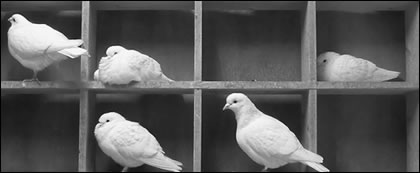
During WWII, in the days before cheap computing, guiding a bomb to its target was a more miss than hit affair. While the military were working on their first crude electronic guidance systems, one famous psychologist, B.F. Skinner, had an unusual idea.
Skinner, who had been developing ways of training animals, thought that an expendable animal with excellent eyesight and high manoeuvrability could be trained to guide anti-aircraft missiles to their targets. And so we continue this series on weird psychology with the imaginatively titled: ‘Project Pigeon’ (Skinner, 1960).
Pigeon-guided missiles
First what was needed was proof of concept so Skinner set up a pigeon training area which consisted of a pigeon in a man’s sock looking at a picture of a ‘target’. The pigeon could then peck on one of four levers that moved the ‘target’ up, down, left and right.
This prototype seemed to work with the pigeons keeping the target in the centre. Skinner thought this was proof that a pigeon-guided missile was a real possibility. In fact, he planned on having three pigeons in the nose cone of each missile, thinking this would provide a more failsafe system.
The military got as far as adapting some missiles to accommodate the pigeons before eventually deciding electronics was a better bet for the future and killed Project Pigeon. They were also understandably nervous about a load of heavily-armed pigeons flying around the skies.
Superstitious pigeons
While the pigeon-guided missile died, the idea of using a box with levers for experimenting with animals lived on in the form of a ‘Skinner box’. It was using this that Skinner then made the surprising claim that pigeons could be superstitious (Skinner, 1948).
A hungry pigeon was placed in a Skinner box and fed once every 15 seconds. But soon it began to exhibit unusual behaviours. In one case it began stretching its neck just before the food was delivered. In another the pigeon started walking in circles. Yet another stuck its head in the corner.
Skinner argued the pigeon had come to associate the movement of its neck, or walking in circles around the box, or sticking its head in the corner with the reward of food. So it now believed it had to move its head to get fed. It had become a superstitious pigeon.
Skinner would give lectures in which an apparently passive pigeon was placed into the Skinner box at the start. After an hour or so the box’s cover would be removed to reveal a pigeon now engaged in some bizarre behaviour.
Personally I think the pigeons got wise. After all, would you rather dance for your supper or be strapped to a missile?


